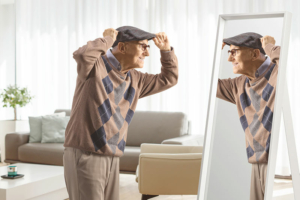The Best Adaptive Clothing for Seniors

Discover how adaptive clothing for seniors can make getting dressed easier, prevent falls, and more.
What were your thoughts when selecting the outfit you put on this morning? Style? Comfort? A certain memory attached to a piece of clothing? The clothes we wear are a fundamental part of our identity, and the simple act of choosing what to wear and being able to put it on is crucial to our independence. When the effects of getting older or a health condition such as arthritis make it hard to self-dress, adaptive clothing is a fantastic way to maintain self-sufficiency.
What Types of Adaptive Clothing Are Ideal?
There are a variety of key features to consider in adaptive clothing for seniors, including:
- How it aids in preventing falls: Don’t forget about footwear! Adaptive shoes are often slip-resistant and they can accommodate a brace or swelling.
- How restrictive it is: Clothing with an elastic waistband or adjustable straps is less restrictive and also works well for someone with fluctuating weight or problems with swelling.
- How easy it is to wash: Choose machine wash/tumble dry clothing made from material that resists wrinkles and will be most comfortable and convenient.
- How it fastens: Buttons and zippers are more difficult to control than Velcro, snaps, or magnets.
- How it is put on: Raising the arms and pulling a snug sweater over the head is much more difficult than slipping on a cardigan. For someone in a wheelchair or with other mobility issues, clothing that opens in the back or on the side is an even better choice.
Will It Fit?
Purchasing adaptive clothing for seniors that is comfortable and fits well isn’t always easy, particularly if you’re ordering clothing online. Here is how to achieve the very best results:
- Measure first. Get an accurate measurement of the individual’s hips, waist, inseam, and for women, bust.
- Check the charts. Many online adaptive clothing sites will provide size charts. Along with the individual’s body measurements, pay attention to whether the garments could have a slim or relaxed fit.
- Try it on. Whenever possible, the most reliable way to ensure a great fit is by trying the items on and having the individual move about to check for mobility, flexibility, and comfort. If a piece of clothing misses the mark in any of those areas, return it or speak with a tailor or seamstress about altering it.
Keep in mind too that although adaptive clothing’s purpose is to make getting dressed safer and easier, that doesn’t mean you have to settle for frumpy frocks! Sit down together and look at patterns, colors, and styles online so the person can choose the items they like best.
Contact CareWorks Health Services for further help with your adaptive clothing needs. We are here to offer tried and true tips, take older adults shopping, provide support with getting dressed, and more. Serving Mission Viejo, Huntington Beach, Seal Beach as well as the surrounding areas, you can contact us any time at (949) 859-4700 to learn more.
